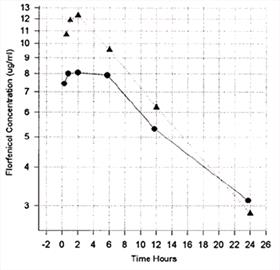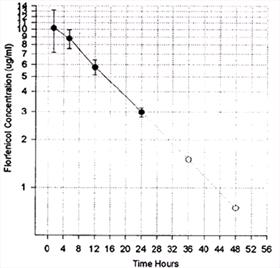Abstract
Florfenicol is a synthetic, broad-spectrum antibiotic chemically similar to chloramphenicol. It is
primarily bacteriostatic, inhibiting bacterial protein synthesis by binding to the 50S ribosomal subunit and inhibiting peptidyl
transferase activity. It was approved for use in cattle for bovine respiratory disease (BRD) complex involving Pasteurella
haemolytica, Pasteurella multocida, and Haemophilus somnus in May of 1996. There are currently no known
interactions between florfenicol and other commonly used antibacterials. In cattle, peak serum levels of 1.43 to 5.60 micrograms
per milliliter (µg/ml) are reached between 0.75 to 8 hours after an intramuscular injection (IM) at 20 milligrams per
kilogram (mg/kg). Minimum inhibitory concentrations (MIC) for P. multocida and H. somnus of 0.5 µg/ml (1.0
µg/ml for P. haemolytica) are maintained for 48 hours.
Serum levels of florfenicol were obtained using high-performance liquid chromatography in two beluga
whales, Delphinapterus leucas, and two bottlenose dolphins, Tursiops truncatus. Serum was collected from the
beluga whales at 0.5 1, 2, 4, 6, 12, and 24 hours to determine the half-life (Figure 1). Florfenicol concentrations in samples
collected at 24 hours from all four animals in this study were 3.82, 3.83, 3.12, and 2.84 µg/ml. Elimination half-live in
the beluga whales was 12.5 hrs (n=2). Concentrations at 48 hours when the second dose is administered were projected to be 0.5
µg/ml (Figure 2). Continued dosing every 48 hours, should result in a potentially beneficial bioaccumulation (Dr. Richard
Sams, Ohio State University, Analytical Toxicology Laboratory, personal communication).
The rate of elimination of this antibiotic does not appear to be affected by the metabolic rate of the
animal (Dr. Sams, personal communication). This was consistent with our data that demonstrated similar 24 hr concentrations
between bottlenose dolphins and beluga whales. We have achieved good clinical results using florfenicol at 20 mg/kg in two
beluga whales. It was administered by deep IM injection with no more than 20 ml per injection site. Treatment was continued for
four injections 48 hours apart. The only adverse reactions noted were mild elevations in serum aspartate aminotransferase (AST)
and lactic dehydrogenase (LDH). These elevations were attributed to muscle trauma at the injection sites and returned to normal
within two weeks after the last injection.
Click on the chart to see a larger view.
| Figure 1. | 
Elimination half-life of florfenicol after a single IM injection at 20 mg/kg in two
beluga whales. |
|
| |
| | Figure 2. | 
Mean elimination curve of florfenicol in beluga whales (n=2). |
|
| |
|
Mean elimination half life was 12.5 hr. Estimated 36 and 48 hour concentrations are illustrated by dotted line
and open circles. MIC ranges from 0.5 to 1.0 ug/ml for Pasteurella sp. and Haemophilis sp.